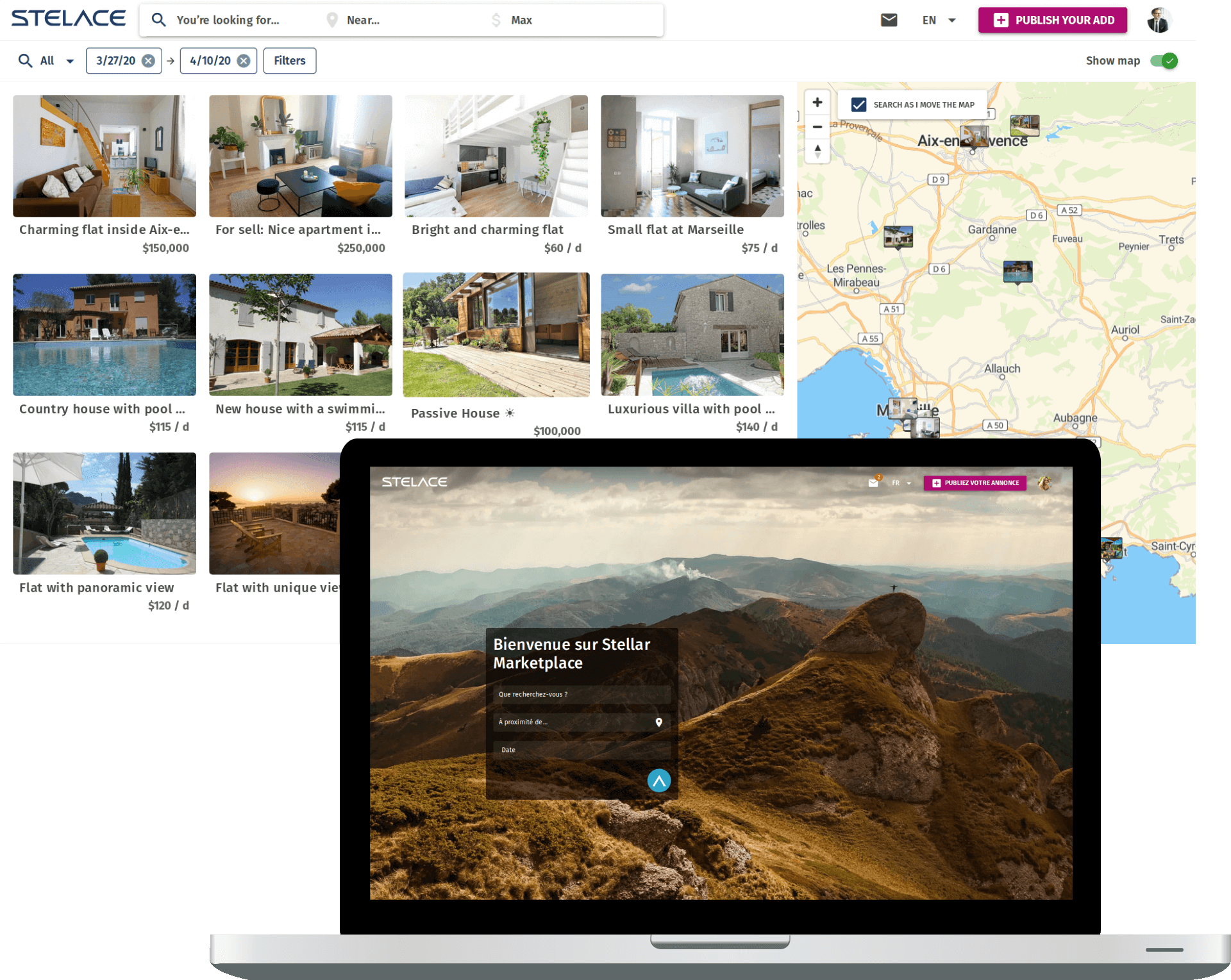Marketplace starter kit
This Stelace starter kit is free to use, under the terms of the MIT license. Feel free to fork, contribute or just make it your own :heart:.
This starter kit offers a high-performance AirBnB-like marketplace front-end (Vue.js) with pre-configured serverless deployment based on open-source Stelace API server.
Contents
A platform template focused on search, automation and real-time is also available.
What is Stelace?
Stelace API provides advanced search, asset and user management, automation and content delivery APIs for Web platforms ranging from search-intensive marketplaces to online community apps. Stelace open-source marketplace backend lets you focus on what makes your platform unique.
Features :gift:
- Asset management. Assets can be anything from flats and homes to cars or concerts
- Powerful and typo-tolerant Search :mag:, on a relevance and dynamic availability basis
- User authentication including social login & SSO
- User management and Ratings :star:
- Real-time Events and Messaging
- Automation with Stelace Workflows :traffic_light:
- Customizable payment process using serverless functions
- Headless CMS :page_with_curl: with Stelace Content API
- Global CDN for images and user files
- i18n :earth_africa: and full translations
- Accessibility
- …
- and much more with Stelace API
Fast by default :checkered_flag:
Get 90+ PageSpeed score out of the box:
- Pre-rendered static pages for fastest page load, with Vue.js hydrating into full SPA.
- Code-splitting with optimized Webpack config in
quasar.conf.js. - Image compression using WebP and serverless resizing using AWS Lambda
- Ressource prefetching and preloading
- PWA-ready thanks to Quasar
This kit follows the PRPL pattern: more info in docs.
Integrations
Leverage these integrations to start running your platform even faster:
- Automated and continuous deployment with Netlify
- Stripe payments using Netlify functions and Stelace workflows
- Sentry for debugging in production environment
- Maps and place search with OpenStreetMap providers
- Google Analytics
Testing
Stack
Serverless JAMStack architecture:
- Vue.js
- Quasar framework
- Stelace API as backend
- Stelace headless CMS
- Stelace.js SDK
- Netlify for static site and lambda functions deployment
Node.js >= 10.18 is used for tooling.
Getting started
You need your Stelace API keys to get started. Good news: Stelace is open-source so you can deploy your own server.
- Clone this repository
git clone https://github.com/stelace/marketplace-demo.git
cd marketplace-demo- Install node_modules
# using yarn instead of npm is recommended
yarnIf you don’t have yarn installed, you can follow these instructions.
- Create environment files for development and production.
You can copy .env.example and fill it with Stelace API keys (generate them with the server-side open-source project).
cp .env.example .env.development
# You may want to use live keys in this file
cp .env.example .env.productionYou need to fill the following environment variables:
STELACE_INSTANT_WEBSITE_URLSTELACE_PUBLISHABLE_API_KEY(pubk_...) used in Vue appSTELACE_SECRET_API_KEY(seck_...) used in data seeding scriptsSTELACE_API_URLcan be left blank unless you use your own server rather than defaultapi.stelace.com
Please refer to .env.example for more details about environment variables, including map, payment gateway, logging and analytics.
- Seed development data
yarn seed- Start the development server
quasar dev
# or, if you want to run Netlify functions with stripe payments as well:
yarn devPlease refer to Quasar docs for more details about front-end configuration and components.
Developing with self-hosted Stelace API server (open-source backend).
Stelace Core API server has to be launched locally before starting this project's server. First we need to launch services needed by Stelace Core API. ```sh yarn docker:db ``` Then we need to initialize the database with Instant configuration. ```sh cd /path/to/stelace-core git checkout dev yarn setup:instant ``` Secret and publishable api keys will be displayed so you can use it as environment variables for this project. You’ll also need to set some environment variables such as `STELACE_API_URL` (http://127.0.0.1:API_PORT). Let’s start the server. ```sh yarn dev ``` Please refer to`.env.example` in `stelace-server` project.- Branding
Customize the app with your own colors and branding in src/styles.json, documented in styles.json.md.
Deployment
Please refer to deployment docs section for more details.


